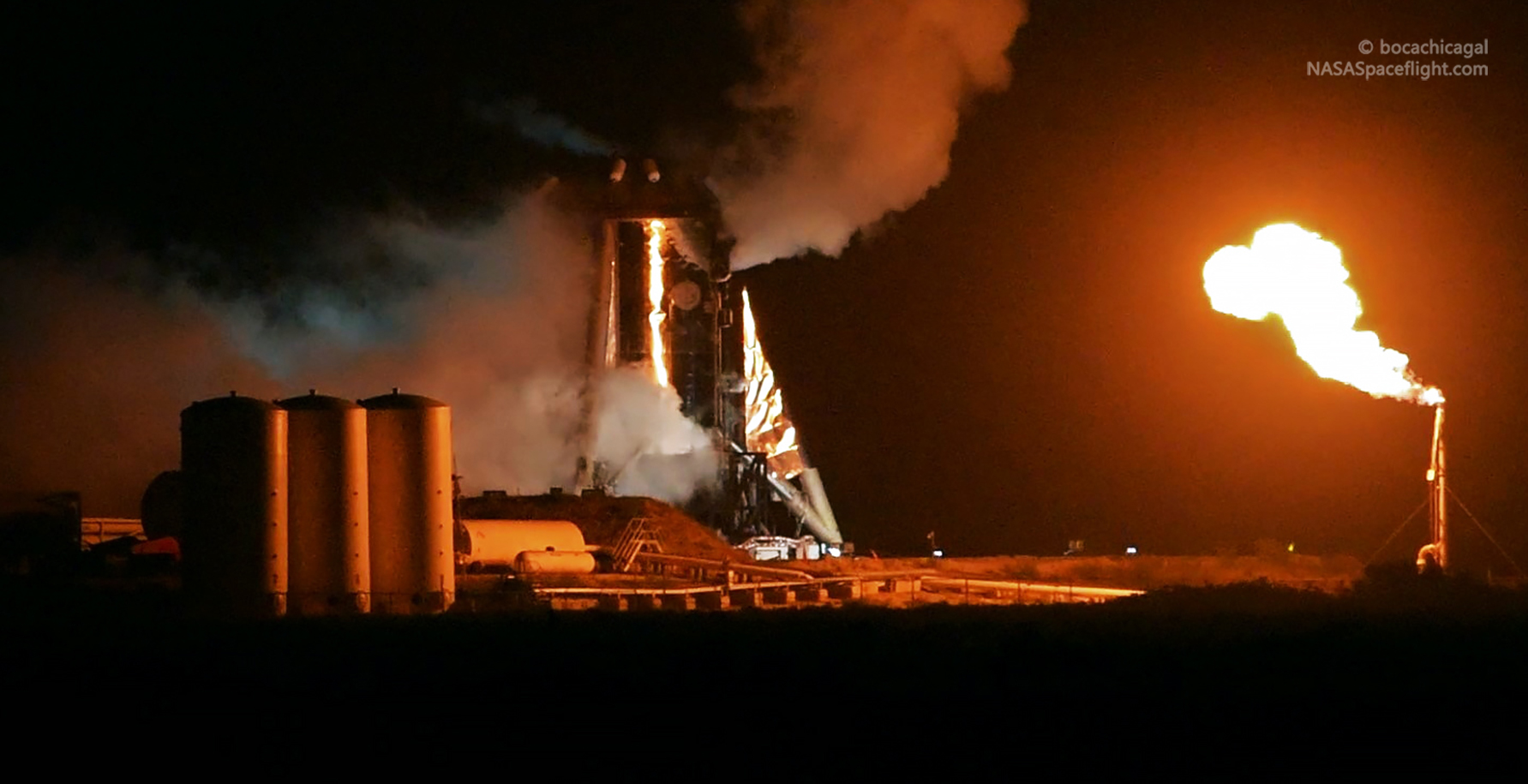
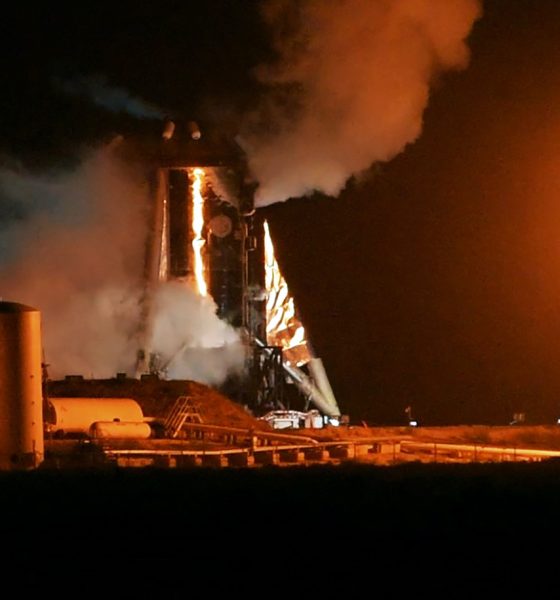
News
SpaceX delays Starhopper’s first flight a few days despite Raptor preburner test success
SpaceX has (partially) ignited Starhopper’s freshly-installed Raptor engine, successfully verifying that the engine is ready for its next major test: a full ignition and static firing. Although successful, SpaceX still has some work to do before the vehicle is ready for its first untethered flight(s).
July 15th’s progress is just the latest in a several day-series of preflight tests designed to reduce the likelihood that Starhopper is destroyed over the coming days and (hopefully) weeks. If all goes planned during the awkward Starship prototype’s first foray into hover tests, SpaceX CEO Elon Musk has stated that he will provide an official presentation updating the public on the status of the company’s ever-changing next-generation rocket.
The past week or so of Starhopper preflight testing began with Raptor serial number 6 (SN06) completing the last of a series of acceptance test fires in McGregor, Texas on June 10th. Even on its own, this was a major milestone for the new SpaceX engine: Raptor SN06 was the first of the new, full-scale engines to pass the acceptance test program with flying colors. According to Musk, for the engine to complete those tests so successfully, SpaceX had to solve a challenging bug in which some sort of mechanical resonance (i.e. vibration) damaged or destroyed Raptors SN01-05.
Hours later, the engine began a short ~450 mi (720 km) journey south to Starhopper, located in Boca Chica, Texas. The engine arrived on July 11th and was fully installed on Starhopper by the following evening (July 12th), at which point SpaceX put Starhopper and Raptor through some mild but valuable thrust vector controller (TVC) tests, wiggling the car-sized engine to ensure it can accurately steer the prototype rocket.
Around two days after the above ‘wiggle’ test was successfully completed, SpaceX moved into the next stage, partially fueling Starhopper with liquid methane and oxygen propellant and helium pressurant in what is known in rocketry as a wet dress rehearsal (WDR). The (implicitly) successful WDR was capped off with a duo of what can now safely be concluded were some sort of Raptor test preceding even pre-ignition operations. Whatever the tests were, they appear to have been completed successfully.
That appears to be the case because less than 24 hours after their completion, on July 15th, SpaceX once again began loading Starhopper with propellant and pressurant for a second round of wet testing. This time around, SpaceX got right into more critical Raptor tests once enough propellant was loaded, igniting the engine’s interwoven oxygen and methane preburners.
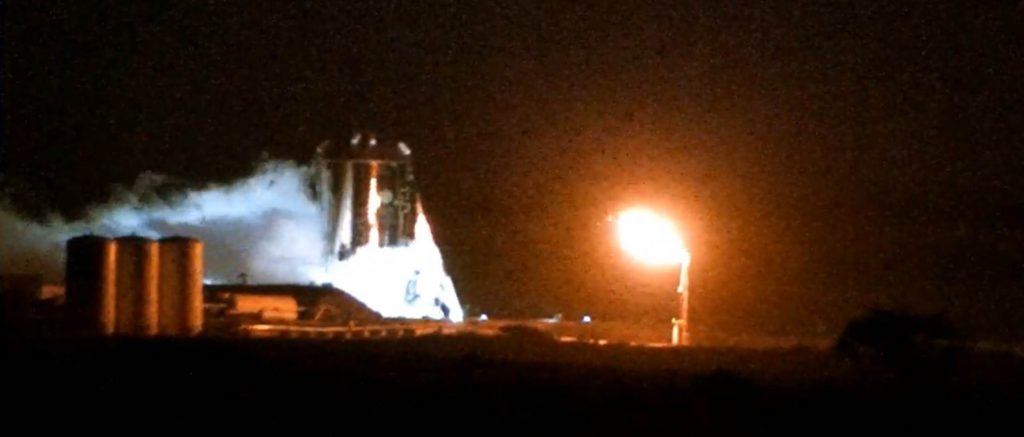
Previously discussed 24 hours ago in a Teslarati article focused on Raptor wiggles and other miscellaneous tests, Raptor is an extremely advanced rocket engine based on a cycle (i.e. how propellant is turned into thrust) known as full-flow staged combustion.
“In a staged-combustion engine like Raptor, getting from the supercool liquid oxygen and methane propellant to 200+ tons of thrust is quite literally staged, meaning that the ignition doesn’t happen all at once. Rather, the preburners – essentially their own, unique combustion chambers – ignite an oxygen- or methane-rich mixture, the burning of which produces the gas and pressure that powers the turbines that bring fuel into the main combustion chamber. That fuel then ignites, producing thrust as they exit the engine’s bell-shaped nozzle.
Unintuitively, conditions inside the preburner – hidden away from view – are actually far more intense than the iconic blue, purple, and pink flame that visibly exists Raptor’s nozzle. Much like hot water will cool while traveling through pipes, the superheated gaseous propellant that Raptor ignites to produce thrust will also cool (and thus lose pressure) as it travels from Raptor’s preburner to its main combustion chamber. If the pressure produced in the preburners is too low, Raptor’s thrust will be (roughly speaking) proportionally limited at best. At worst, low pressure in the preburners can trigger a “hard start” or shutdown that could destroy the engine. According to Elon Musk, Raptor’s oxygen preburner thus has the worst of it, operating at pressures as high or higher than 800 bar (11,600 psi, 80 megapascals).”
In full-flow staged combustion (FFSC), even more complexity is added as all propellant that touches the engine must necessarily end up traveling through the main combustion chamber to eke every last ounce of thrust out of the finite propellant a rocket lifts off with. As such, FFSC engines can be about as efficient as the laws of physics allow any given chemical rocket engine to be, at the cost of exceptional complexity and brutally difficult development.
Additionally, FFSC physically requires two separate preburners and then makes things even harder by making each separate preburner (methane and oxygen) depend on each other’s operation for the engine to fully ignite. This means that no individual preburner can be used to kickstart Raptor – instead, SpaceX must somehow spin the turbopumps that feed propellant into each preburner with some separate system. This is all just to emphasize the fact that Raptor’s ignition sequence is a spectacularly complex orchestra of valves, spark plugs, sensors, and magic. This is why it’s valuable for Raptor to test its preburner system independently of an actual ignition test, at least as long as the engine is still in the development stages.
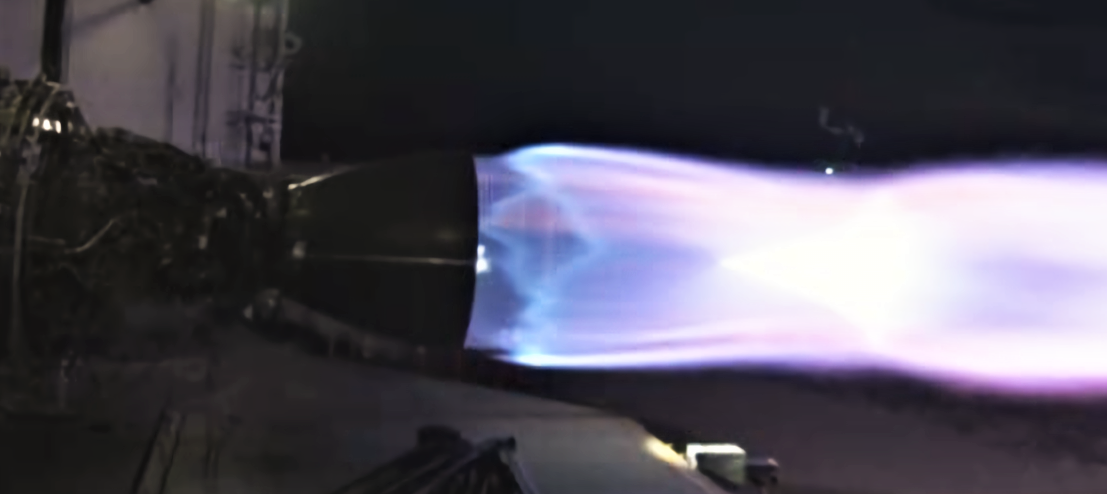
According to NASASpaceflight.com managing editor Chris Bergin, what this practically translates to is a minor Starhopper hover test delay of 1-2 days, while the static fire has also been pushed roughly 24 hours from July 15th to July 16th. If that full static fire produces lots of happy data, Starhopper could be cleared for a hover test debut attempt as early as Wednesday or Thursday (July 17/18).
Check out Teslarati’s Marketplace! We offer Tesla accessories, including for the Tesla Cybertruck and Tesla Model 3.

Cybertruck
Tesla Cybertruck earns IIHS Top Safety Pick+ award
To commemorate the accolade, the official Cybertruck account celebrated the milestone on X.

The Tesla Cybertruck has achieved the Insurance Institute for Highway Safety’s (IIHS) highest honor, earning a Top Safety Pick+ rating for 2025 models built after April 2025.
The full-size electric pickup truck’s safety rating is partly due to the vehicle’s strong performance in updated crash tests, superior front crash prevention, and effective headlights, among other factors. To commemorate the accolade, the official Cybertruck account celebrated the milestone on X.
Cybertruck’s IIHS rating
As per the IIHS, beginning with 2025 Cybertruck models built after April 2025, changes were made to the front underbody structure and footwell to improve occupant safety in driver-side and passenger-side small overlap front crashes. The moderate overlap front test earned a good rating, and the updated side impact test also received stellar marks.
The Cybertruck’s front crash prevention earned a good rating in pedestrian scenarios, with the standard Collision Avoidance Assist avoiding collisions in day and night tests across child, adult crossing, and parallel paths. Headlights with high-beam assist compensated for limitations, contributing to the top award.
Safest and most autonomous pickup
The Cybertruck is one of only two full-size pickups to receive the IIHS’ Top Safety Pick + rating. It is also the only one equipped with advanced self-driving features via Tesla’s Full Self-Driving (Supervised) system. Thanks to FSD, the Cybertruck can navigate inner city streets and highways on its own with minimal supervision, adding a layer of safety beyond passive crash protection.
Community reactions poured in, with users praising the vehicle’s safety rating amidst skepticism from critics. Tesla itself highlighted this by starting its X post with a short clip of a Cybertruck critic who predicted that the vehicle will likely not pass safety tests. The only question now is, of course, if the vehicle’s Top Safety Pick+ rating from the IIHS will help the Cybertruck improve its sales.
News
Tesla stands to gain from Ford’s decision to ditch large EVs
Tesla is perhaps the biggest beneficiary of Ford’s decision, especially as it will no longer have to deal with the sole pure EV pickup that outsold it from time to time: the F-150 Lightning.
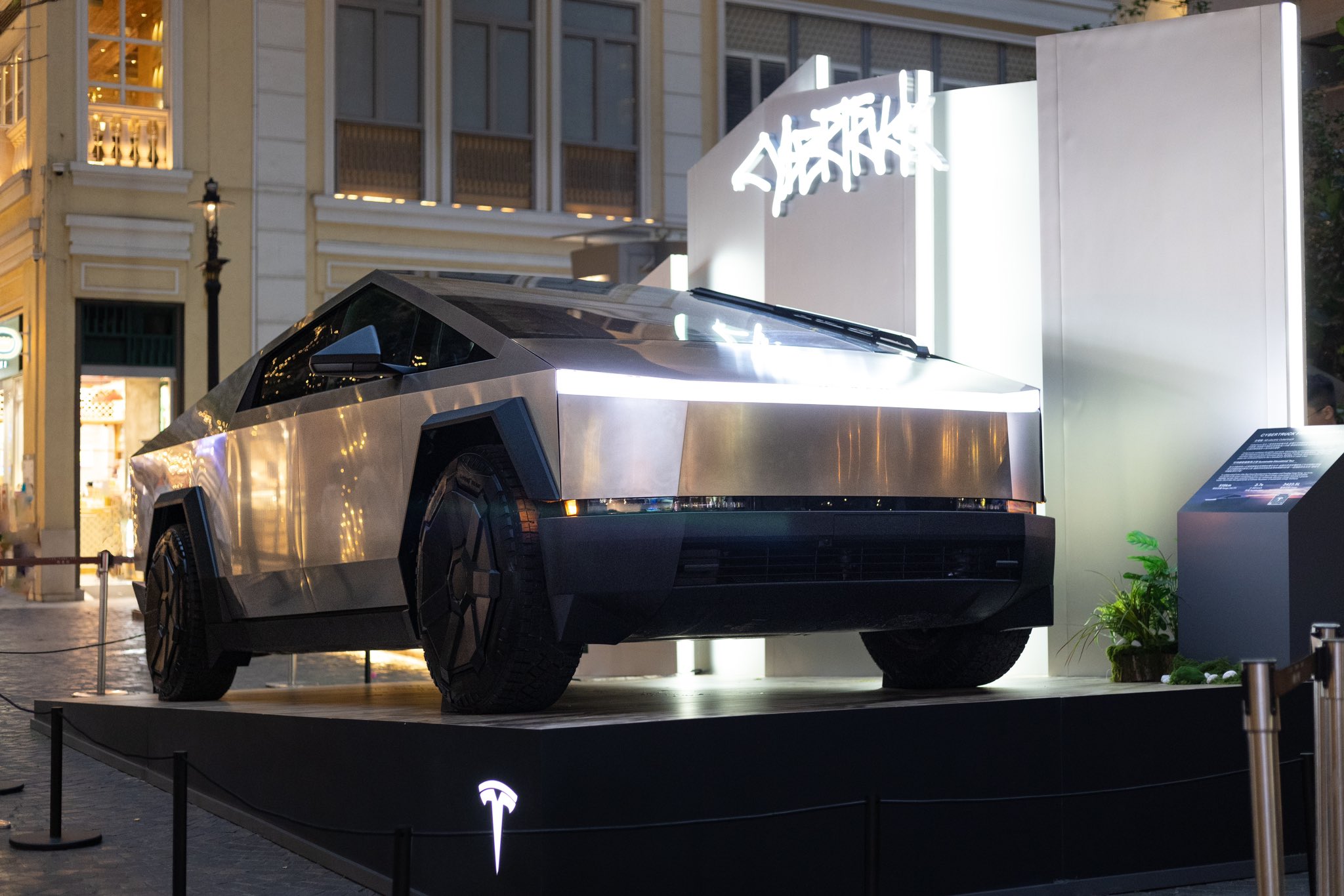
Ford’s recent decision to abandon production of the all-electric Ford F-150 Lightning after the 2025 model year should yield some advantages for Tesla.
The Detroit-based automaker’s pivot away from large EVs and toward hybrids and extended-range EVs that come with a gas generator is proof that sustainable powertrains are easy on paper, but hard in reality.
Tesla is perhaps the biggest beneficiary of Ford’s decision, especially as it will no longer have to deal with the sole pure EV pickup that outsold it from time to time: the F-150 Lightning.
Here’s why:
Reduced Competition in the Electric Pickup Segment
The F-150 Lightning was the Tesla Cybertruck’s primary and direct rival in the full-size electric pickup market in the United States. With Ford’s decision to end pure EV production of its best-selling truck’s electric version and shifting to hybrids/EREVs, the Cybertruck faces significantly less competition.
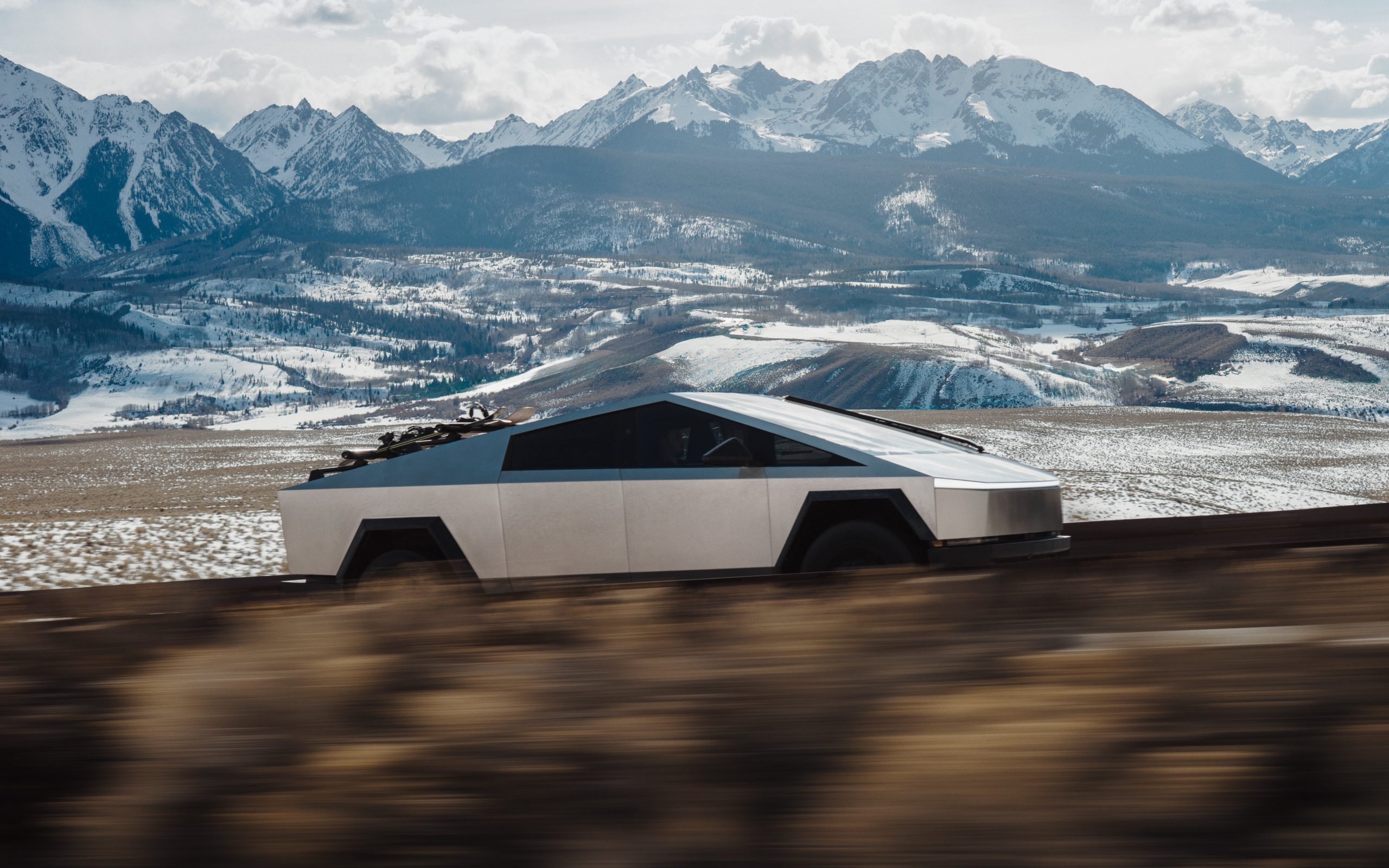
Credit: Tesla
This could drive more fleet and retail buyers toward the Cybertruck, especially those committed to fully electric vehicles without a gas generator backup.
Strengthened Market Leadership and Brand Perception in Pure EVs
Ford’s pullback from large EVs–citing unprofitability and lack of demand for EVs of that size–highlights the challenges legacy automakers face in scaling profitable battery-electric vehicles.
Tesla, as the established leader with efficient production and vertical integration, benefits from reinforced perception as the most viable and committed pure EV manufacturer.
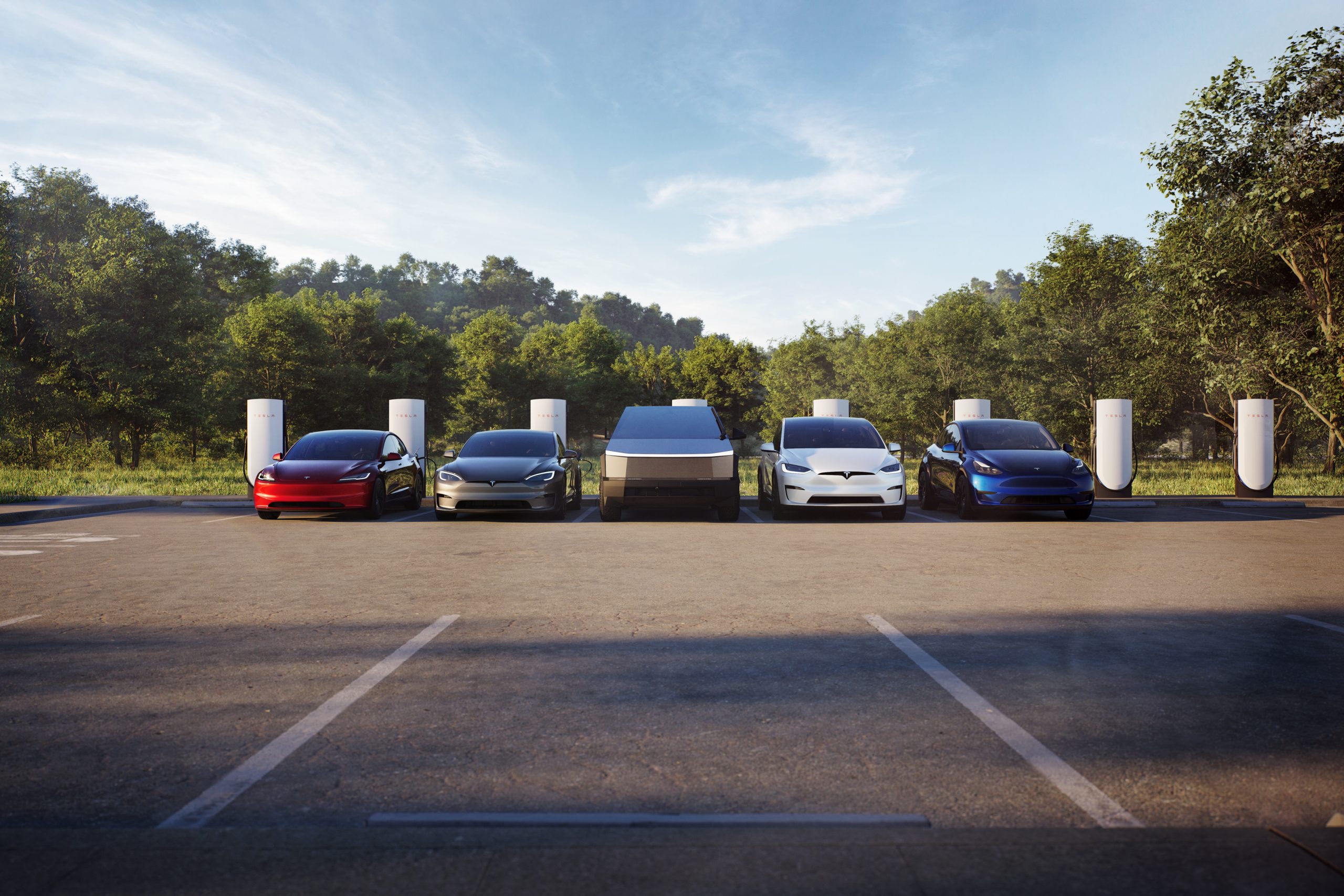
Credit: Tesla
This can boost consumer confidence in Tesla’s long-term ecosystem over competitors retreating to hybrids. With Ford making this move, it is totally reasonable that some car buyers could be reluctant to buy from other legacy automakers.
Profitability is a key reason companies build cars; they’re businesses, and they’re there to make money.
However, Ford’s new strategy could plant a seed in the head of some who plan to buy from companies like General Motors, Stellantis, or others, who could have second thoughts. With this backtrack in EVs, other things, like less education on these specific vehicles to technicians, could make repairs more costly and tougher to schedule.
Potential Increases in Market Share for Large EVs
Interestingly, this could play right into the hands of Tesla fans who have been asking for the company to make a larger EV, specifically a full-size SUV.
Customers seeking large, high-capability electric trucks or SUVs could now look to Tesla for its Cybertruck or potentially a future vehicle release, which the company has hinted at on several occasions this year.
With Ford reallocating resources away from large pure EVs and taking a $19.5 billion charge, Tesla stands to capture a larger slice of the remaining demand in this segment without a major U.S. competitor aggressively pursuing it.
News
Ford cancels all-electric F-150 Lightning, announces $19.5 billion in charges
“Rather than spending billions more on large EVs that now have no path to profitability, we are allocating that money into higher returning areas, more trucks and van hybrids, extended range electric vehicles, affordable EVs, and entirely new opportunities like energy storage.”
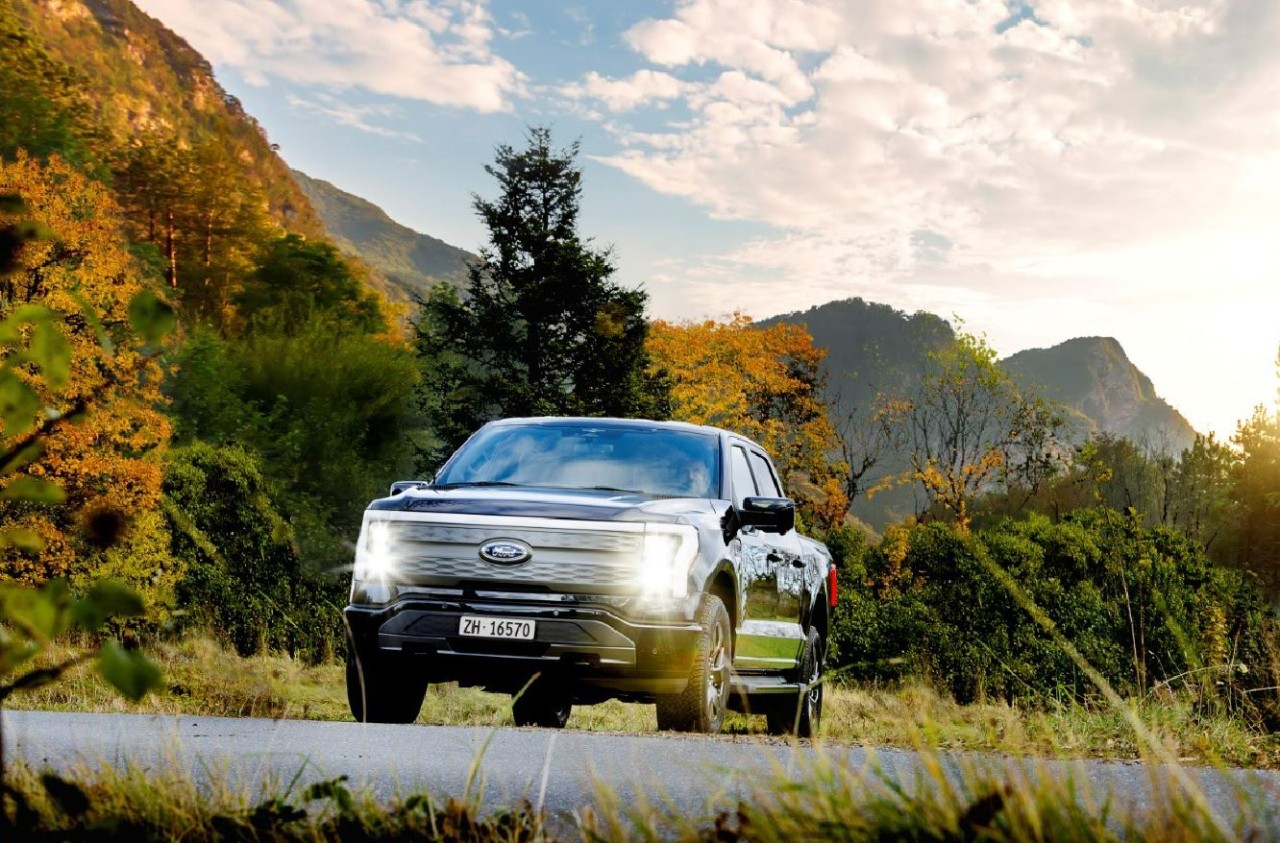
Ford is canceling the all-electric F-150 Lightning and also announced it would take a $19.5 billion charge as it aims to quickly restructure its strategy regarding electrification efforts, a massive blow for the Detroit-based company that was once one of the most gung-ho on transitioning to EVs.
The announcement comes as the writing on the wall seemed to get bolder and more identifiable. Ford was bleeding money in EVs and, although it had a lot of success with the all-electric Lightning, it is aiming to push its efforts elsewhere.
It will also restructure its entire strategy on EVs, and the Lightning is not the only vehicle getting the boot. The T3 pickup, a long-awaited vehicle that was developed in part of a skunkworks program, is also no longer in the company’s plans.
Instead of continuing on with its large EVs, it will now shift its focus to hybrids and “extended-range EVs,” which will have an onboard gasoline engine to increase traveling distance, according to the Wall Street Journal.
“Ford no longer plans to produce select larger electric vehicles where the business case has eroded due to lower-than-expected demand, high costs, and regulatory changes,” the company said in a statement.
🚨 Ford has announced it is discontinuing production of the F-150 Lightning, as it plans to report a charge of $19.5 billion in special items.
The Lightning will still be produced, but instead with a gas generator that will give it over 700 miles of range.
“Ford no longer… pic.twitter.com/ZttZ66SDHL
— TESLARATI (@Teslarati) December 15, 2025
While unfortunate, especially because the Lightning was a fantastic electric truck, Ford is ultimately a business, and a business needs to make money.
Ford has lost $13 billion on its EV business since 2023, and company executives are more than aware that they gave it plenty of time to flourish.
Andrew Frick, President of Ford, said:
“Rather than spending billions more on large EVs that now have no path to profitability, we are allocating that money into higher returning areas, more trucks and van hybrids, extended range electric vehicles, affordable EVs, and entirely new opportunities like energy storage.”
CEO Jim Farley also commented on the decision:
“Instead of plowing billions into the future knowing these large EVs will never make money, we are pivoting.”
Farley also said that the company now knows enough about the U.S. market “where we have a lot more certainty in this second inning.”








